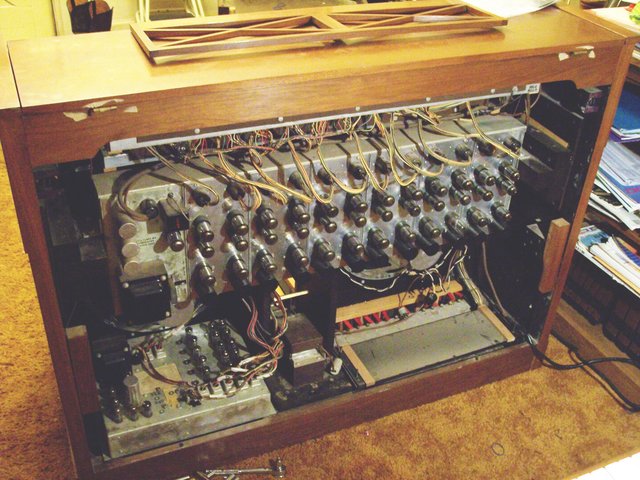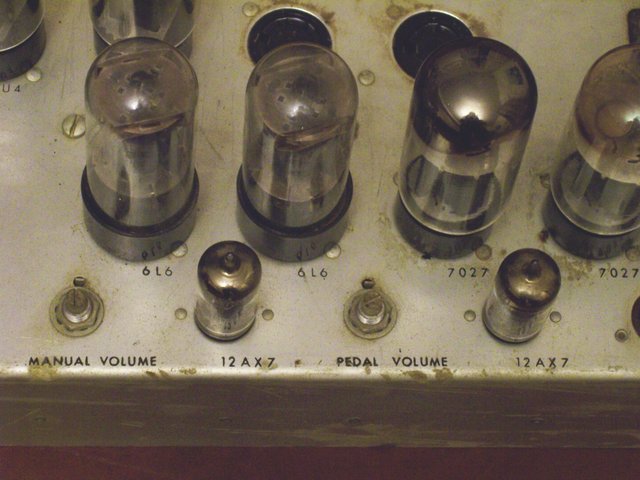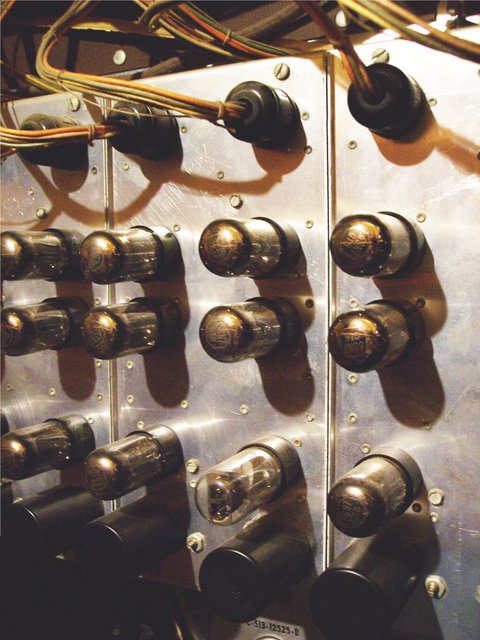My friend Lawrence’s son Jacob has just been given a Baldwin Electronic Organ, model 45HP2. It’s big and old and made with vacuum tubes and point-to-point wiring (no printed circuit boards), and it has a problem: The speaker for the pedals (that you press with your feet) continually puts out static that sounds like a low-pitched crackle. It’s definitely not 60Hz hum, nor does it sound like turntable rumble — it’s very irregular in both pitch and amplitude.
Particularly vexing is that the organ was reported to work perfectly before it was moved 60+ miles in a U-Haul-type trailer. So whatever is wrong with it probably has a mechanical origin — a damaged tube, a part or connector that needs to be reseated, or a joint that needs to be resoldered.
The amplifier chassis has separate volume controls for the manual (keyboard) and pedal (footboard), and turning the pedal volume all the way down eliminates the noise. So it definitely seems to be coming from the pedal section — either a tone generator or the amplifier.
The problem would be easy to repair if it were a simple matter of replacing a bad vacuum tube, so we’ve started investigating in that direction. I had Jake swap the two 12AX7 tubes on the amplifier to see whether the problem followed the tube to the manual speaker, but no change. I should probably have him swap the 616s and 7027s as well.
The tone generators run across the upper part of the back of the organ, with a column for each note of the scale, two columns per “board.” I believe the connector at the top brings in the “requests” for that tone in each octave — probably in analog form, as a sum of all the different sources needing that pitch (for a fundamental or harmonic frequency).
The boards are presumably the oscillators, and there’s a bus (I assume the tone output bus) made of 1/8″ rods at the bottom of the inside of the cage. My guess is that the pedal tones go onto a different rod in the bus than the manual tones; but without a schematic, with the high voltages I expect are present in a tube system, and with not much time spent so far, I haven’t tried to determine which one. It’d be fruitful to disconnect the pedal tone generator output from the amplifier, to isolate the problem to the oscillator or amplifier section, if we knew which it was.
All of the oscillator tubes are identical (6SN7 GTB), and I did have Jake rotate them within all the oscillators (top two down one, bottom to top), thinking that if an oscillator tube were the problem, the nature of the noise might change if the tube were in a different position. No change so far.
If there’s anyone out there with experience with this type of thing, I’d be very grateful for any advice you want to throw my way.



I have no experience with this organ, although I believe it was one of the early solid state versions that Baldwin produced. I believe the transposer had something to do with electronically changing the key. You might want to jump into thiis organ forum. There seems to be a good discusson of the C-601 taking place. Good luck!!
http://organforum.com/forums/thread/54879.aspx
In view of the large number of pins and contacts in any organ, my favorite method after a move is to unplug and re-plug all tubes, plugs, etc. I also mark all audio level controls with their current position and then exercise them. Should this not solve the problem I again unplug items and gently clean them with a toothbrush sprayed with de-natured alcohol. If noise is unaffected by the expression pedal, I concentrate on the power amp section. A signal tracer placed across the gain control will help confirm where the noise originates.
Please tell me about the footpedals and what is the “composite” that is under the pedals that presses the sensors. Where do I purchase it, etc.?
MO, I have no idea. I believe this organ used bare spring wire pressed against button contacts, so you’re talking about something I haven’t seen.
i have listend to your mp3 sound file and it sounds to me that you may
have a short circuit in a pre-amp vale